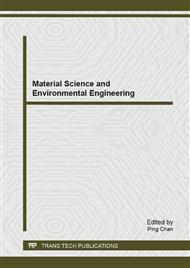[1]
P. Spégel, L. Schweitz, S. Nilsson, Molecularly imprinted microparticles for capillary electrochromatography: Studies on microparticle synthesis and electrolyte composition, Electrophoresis. 22(2001) 3833-3841.
DOI: 10.1002/1522-2683(200109)22:17<3833::aid-elps3833>3.0.co;2-9
Google Scholar
[2]
F. Priego-Capote, L. Ye, S. Shakil, S A. Shamsi, S. Nilsson, Monoclonal Behavior of Molecularly Imprinted Polymer Nanoparticles in Capillary Electrochromatography, Anal. Chem. 80(2008) 2881-2887.
DOI: 10.1021/ac070038v
Google Scholar
[3]
P. Spégel, L. Schweitz, S. Nilsson, Selectivity toward Multiple Predetermined Targets in Nanoparticle Capillary Electrochromatography, Anal. Chem. 75(2003) 6608-6613.
DOI: 10.1021/ac034732w
Google Scholar
[4]
Y C. Huang, C C. Lin, C Y. Liu, Preparation and evaluation of molecularly imprinted polymers based on 9-ethyladenine for the recognition of nucleotide bases in capillary electrochromatography, Electrophoresis. 25(2004)554- 561.
DOI: 10.1002/elps.200305735
Google Scholar
[5]
S A. Zaidi, W J. Cheong, Preparation of an open-tubular capillary column with a monolithic layer of S-ketoprofen imprinted and 4-styrenesulfonic acid incorporated polymer and its enhanced chiral separation performance in capillary electrochromatography, J. Chromatogr. A. 1216 (2009).
DOI: 10.1016/j.chroma.2008.08.015
Google Scholar
[6]
C. Cacho, L. Schweitz, E. Turiel, C. Perez-Conde, Molecularly imprinted capillary electrochromatography for selective determination of thiabendazole in citrus samples, J. Chromatogr. A. 1179(2008) 216-223.
DOI: 10.1016/j.chroma.2007.11.097
Google Scholar
[7]
Z S. Liu, C. Zheng, C. Yan, R Y. Gao, Molecularly imprinted polymers as a tool for separation in CEC, Electrophoresis. 28(2007)127-136.
DOI: 10.1002/elps.200600544
Google Scholar
[8]
H F. Wang, Y Z. Zhu, X P. Yan, R Y. Gao, J Y. Zheng, A Room Temperature Ionic Liquid (RTIL)-Mediated, Non-Hydrolytic Sol–Gel Methodology to Prepare Molecularly Imprinted, Silica-Based Hybrid Monoliths for Chiral Separation, Adv. Mater. 18(2006).
DOI: 10.1002/adma.200601024
Google Scholar
[9]
H F. Wang, Y Z. Zhu, X P. Yan, J P. Lin, Fabrication of molecularly imprinted hybrid monoliths via a room emperature ionic liquid一mediated nonhydrolytic sol-gel route for chiral separation of zolmitriptan by capillary electrochromatography, Electrophoresis. 29(2008).
DOI: 10.1002/elps.200700402
Google Scholar
[10]
J X. He, G Z. Fang, Q L. Deng, S. Wang, Preparation, characterization and application of organic一inorganic hybrid ractopamine multi一template molecularly imprinted capillary monolithic column, Anal. Chim. Acta. 692(2011) 57-62.
DOI: 10.1016/j.aca.2011.02.056
Google Scholar
[11]
J X. He, G Z. Fang , Y C. Yao, S. Wang, Preparation and characterization of molecularly imprinted silica monolith for screening sulfamethazine, J. Sep. Sci. 33(2010) 3263-3271.
DOI: 10.1002/jssc.200900650
Google Scholar
[12]
J. Zhang, H K. Lee, Application of liquid-phase microextraction and on-column derivatization combined with gas chromatography–mass spectrometry to the determination of carbamate pesticides, J. Chromatogr. A. 1117(2006)31-37.
DOI: 10.1016/j.chroma.2006.03.102
Google Scholar
[13]
B. Mickova, T. Kovalczuk, P. Rauch, M J. Moreno, A. Abad, A. Montoya, E. Ferri, F. Fini, S. Girotti, Analytical performances of validated chemiluminescent enzyme immunoassays to detect N-methylcarbamate pesticides, Anal. Chim. Acta. 528(2005).
DOI: 10.1016/j.aca.2004.09.066
Google Scholar
[14]
E. Mauriz, A. Calle, A. Abad, A. Montoya, A. Hildebrandt, D. Barceló, L M. Lechuga, Determination of carbaryl in natural water samples by a surface plasmon resonance flow-through immunosensor, Biosen. Bioelectron. 21(2006)2129-2136.
DOI: 10.1016/j.bios.2005.10.013
Google Scholar
[15]
C. Zhang, GP. Ma, GZ. Fang, Y. Zhang, S. Wang, Development of a Capillary Electrophoresis-Based Immunoassay with Laser-Induced Fluorescence for the Detection of Carbaryl in Rice Samples, J. Agric. Food Chem. 56(2008) 8832-8837.
DOI: 10.1021/jf801645m
Google Scholar


